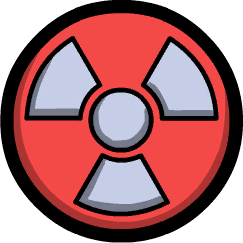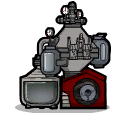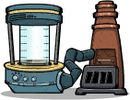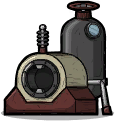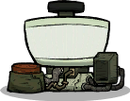Metal Refinery
Metal Refinery is a Refinement Building, which serves the purpose of turning Metal Ore into Refined Metal, as well as producing alloys. It produces a lot of heat, and dumps part of it into coolant liquid.
Mechanics
A Metal Refinery requires a Liquid Intake and Output Pipes, 400 kg of Liquid as a coolant (stores 800 kg, and can accept 400 more while the task is scheduled), Duplicant operation, and 1.2 kW of Power. It refines metals 100 kg at a time, leaving the Refined Metal on the floor at 40 °C, as well as producing 16 kDTU/s of heat and outputting 400 kg of coolant at a higher temperature. The heat added to the coolant is 80% of the heat required to heat the refined metal from 40 °C to its melting point. Recipes take 40 seconds but it can be reduced by the Machinery attribute.
While the Metal Refinery can operate with just 400 kg of coolant, it is advised to supply 800-1200 kg so that it can operate continuously.
| Input | Output | Added Heat [DTU] |
Rate [DTU/s] | Temperature Increase ( |
Temperature Increase ( |
Temperature Increase ( |
Temperature Increase ( |
|---|---|---|---|---|---|---|---|
| |
|
10,566,648 | 264,166.2 | 6.32 | 15.63 | 15.01 | 3.13 |
| |
|
20,979,100 | 524,477.5 | 12.55 | 31.03 | 29.80 | 6.21 |
| |
|
32,152,120 | 803,803.0 | 19.23 | 47.56 | 45.67 | 9.52 |
| |
|
36,256,000 | 906,400.0 | 21.69 | 53.63 | 51.50 | 10.74 |
| |
|
45,157,840 | 1,128,946.0 | 27.01 | 66.80 | 64.14 | 13.38 |
| |
|
48,810,720 | 1,220,268.0 | 29.20 | 72.21 | 69.33 | 14.46 |
| |
|
51,661,220 | 1,291,530.5 | 30.91 | 76.42 | 73.38 | 15.30 |
| |
|
53,696,808 | 1,342,420.2 | 32.12 | 79.43 | 76.27 | 15.91 |
| |
|
53,696,808 | 1,342,420.2 | 32.12 | 79.43 | 76.27 | 15.91 |
|
70 kg |
|
93,566,480 | 2,339,162.0 | 55.97 | 138.41 | 132.91 | 27.72 |
Choosing Coolant Liquid
Often the best choice is based on availability, specifically practicality and quantity. ![]() Brine or
Brine or ![]() Polluted Water fresh from a Geyser is about -10°C, for example. This water is typically unsuitable for a Water Sieve or Desalinator: the water freezes as soon as it is extracted and breaks the output pipe. The Metal Refinery typically adds just enough heat to enable water extraction. Alternatively, the colony could run it through the refinery more than once so it's hot enough for Pincha Pepperplants to drink without getting too cold.
Polluted Water fresh from a Geyser is about -10°C, for example. This water is typically unsuitable for a Water Sieve or Desalinator: the water freezes as soon as it is extracted and breaks the output pipe. The Metal Refinery typically adds just enough heat to enable water extraction. Alternatively, the colony could run it through the refinery more than once so it's hot enough for Pincha Pepperplants to drink without getting too cold.
Liquids where the temperature increment is bigger than the temperature range between solid and gaseous transition are struck out. Liquids that can only perform one operation at a time are underlined.
All temperature ranges are 6 degrees larger than stated here, since materials need to go 3°C beyond a phase change temperature to actually change their state.
| Coolant | SHC | Temperature rise with output | ||||||||
|---|---|---|---|---|---|---|---|---|---|---|
| | | | | | | | | | ||
| | 3.4 1.89 | 2.61 °C+4.7 °F | 7.77 °C+13.99 °F | 23.64 °C+42.55 °F | 26.66 °C+47.99 °F | 33.20 °C+59.76 °F | 35.94 °C+64.69 °F | 37.99 °C+68.38 °F | 39.48 °C+71.06 °F | 68.80 °C+123.84 °F |
| | 0.48 0.27 | 18.48 °C+33.26 °F | 55.03 °C+99.05 °F | 167.45 °C+301.41 °F | 188.82 °C+339.88 °F | 235.20 °C+423.36 °F | 254.60 °C+458.28 °F | 269.07 °C+484.33 °F | 279.66 °C+503.39 °F | 487.32 °C+877.18 °F |
| | 1.69 0.94 | 5.25 °C+9.45 °F | 15.63 °C+28.13 °F | 47.56 °C+85.61 °F | 53.63 °C+96.53 °F | 66.80 °C+120.24 °F | 72.31 °C+130.16 °F | 76.42 °C+137.56 °F | 79.43 °C+142.97 °F | 138.41 °C+249.14 °F |
| | 4.179 2.32 | 2.12 °C+3.82 °F | 6.32 °C+11.38 °F | 19.23 °C+34.61 °F | 21.69 °C+39.04 °F | 27.01 °C+48.62 °F | 29.24 °C+52.63 °F | 30.91 °C+55.64 °F | 32.12 °C+57.82 °F | 55.97 °C+100.75 °F |
| | 0.846 0.47 | 10.48 °C+18.86 °F | 31.22 °C+56.2 °F | 95.01 °C+171.02 °F | 107.13 °C+192.83 °F | 133.45 °C+240.21 °F | 144.45 °C+260.01 °F | 152.66 °C+274.79 °F | 158.67 °C+285.61 °F | 276.49 °C+497.68 °F |
| | 2.4 1.33 | 3.70 °C+6.66 °F | 11.01 °C+19.82 °F | 33.49 °C+60.28 °F | 37.76 °C+67.97 °F | 47.04 °C+84.67 °F | 50.92 °C+91.66 °F | 53.81 °C+96.86 °F | 55.93 °C+100.67 °F | 97.46 °C+175.43 °F |
| | 2.191 1.22 | 4.05 °C+7.29 °F | 12.06 °C+21.71 °F | 36.68 °C+66.02 °F | 41.37 °C+74.47 °F | 51.53 °C+92.75 °F | 55.78 °C+100.4 °F | 58.95 °C+106.11 °F | 61.27 °C+110.29 °F | 106.76 °C+192.17 °F |
| | 1.01 0.56 | 8.78 °C+15.8 °F | 26.15 °C+47.07 °F | 79.58 °C+143.24 °F | 89.74 °C+161.53 °F | 111.78 °C+201.2 °F | 121.00 °C+217.8 °F | 127.87 °C+230.17 °F | 132.91 °C+239.24 °F | 231.60 °C+416.88 °F |
| | 0.7697 0.43 | 11.52 °C+20.74 °F | 34.32 °C+61.78 °F | 104.43 °C+187.97 °F | 117.75 °C+211.95 °F | 146.67 °C+264.01 °F | 158.77 °C+285.79 °F | 167.80 °C+302.04 °F | 174.40 °C+313.92 °F | 303.90 °C+547.02 °F |
| | 0.7 0.39 | 12.67 °C+22.81 °F | 37.74 °C+67.93 °F | 114.82 °C+206.68 °F | 129.48 °C+233.06 °F | 161.28 °C+290.3 °F | 174.58 °C+314.24 °F | 184.50 °C+332.1 °F | 191.77 °C+345.19 °F | 334.16 °C+601.49 °F |
| | 4.1 2.28 | 2.16 °C+3.89 °F | 6.44 °C+11.59 °F | 19.60 °C+35.28 °F | 22.11 °C+39.8 °F | 27.54 °C+49.57 °F | 29.81 °C+53.66 °F | 31.50 °C+56.7 °F | 32.74 °C+58.93 °F | 57.05 °C+102.69 °F |
| | 1 0.56 | 8.87 °C+15.97 °F | 26.42 °C+47.56 °F | 80.38 °C+144.68 °F | 90.63 °C+163.13 °F | 112.89 °C+203.2 °F | 122.21 °C+219.98 °F | 129.15 °C+232.47 °F | 134.24 °C+241.63 °F | 233.91 °C+421.04 °F |
| | 0.14 0.08 | 63.35 °C+114.03 °F | 188.68 °C+339.62 °F | 574.12 °C+1033.42 °F | 647.38 °C+1165.28 °F | 806.39 °C+1451.5 °F | 872.91 °C+1571.24 °F | 922.52 °C+1660.54 °F | 958.84 °C+1725.91 °F | 1670.79 °C+3007.42 °F |
| | 0.91 0.51 | 9.75 °C+17.55 °F | 29.03 °C+52.25 °F | 88.33 °C+158.99 °F | 99.60 °C+179.28 °F | 124.06 °C+223.31 °F | 134.29 °C+241.72 °F | 141.93 °C+255.47 °F | 147.51 °C+265.52 °F | 257.05 °C+462.69 °F |
| | 0.71 0.39 | 12.49 °C+22.48 °F | 37.20 °C+66.96 °F | 113.21 °C+203.78 °F | 127.65 °C+229.77 °F | 159.01 °C+286.22 °F | 172.12 °C+309.82 °F | 181.91 °C+327.44 °F | 189.07 °C+340.33 °F | 329.45 °C+593.01 °F |
| | 0.386 0.21 | 22.98 °C+41.36 °F | 68.43 °C+123.17 °F | 208.23 °C+374.81 °F | 234.80 °C+422.64 °F | 292.47 °C+526.45 °F | 316.60 °C+569.88 °F | 334.59 °C+602.26 °F | 347.77 °C+625.99 °F | 605.99 °C+1090.78 °F |
| | 0.2 0.11 | 44.35 °C+79.83 °F | 132.08 °C+237.74 °F | 401.88 °C+723.38 °F | 453.17 °C+815.71 °F | 564.47 °C+1016.05 °F | 611.04 °C+1099.87 °F | 645.77 °C+1162.39 °F | 671.19 °C+1208.14 °F | 1169.56 °C+2105.21 °F |
| | 0.1291 0.07 | 68.70 °C+123.66 °F | 204.61 °C+368.3 °F | 622.59 °C+1120.66 °F | 702.04 °C+1263.67 °F | 874.47 °C+1574.05 °F | 946.61 °C+1703.9 °F | 1000.41 °C+1800.74 °F | 1039.79 °C+1871.62 °F | 1811.86 °C+3261.35 °F |
| | 0.449 0.25 | 19.75 °C+35.55 °F | 58.83 °C+105.89 °F | 179.01 °C+322.22 °F | 201.86 °C+363.35 °F | 251.44 °C+452.59 °F | 272.18 °C+489.92 °F | 287.65 °C+517.77 °F | 298.97 °C+538.15 °F | 520.96 °C+937.73 °F |
| | 0.42 0.23 | 21.12 °C+38.02 °F | 62.89 °C+113.2 °F | 191.37 °C+344.47 °F | 215.79 °C+388.42 °F | 268.80 °C+483.84 °F | 290.97 °C+523.75 °F | 307.51 °C+553.52 °F | 319.61 °C+575.3 °F | 556.93 °C+1002.47 °F |
| | 0.128 0.07 | 69.29 °C+124.72 °F | 206.37 °C+371.47 °F | 627.94 °C+1130.29 °F | 708.07 °C+1274.53 °F | 881.99 °C+1587.58 °F | 954.75 °C+1718.55 °F | 1009.01 °C+1816.22 °F | 1048.73 °C+1887.71 °F | 1827.43 °C+3289.37 °F |
| | 0.265 0.15 | 33.47 °C+60.25 °F | 99.68 °C+179.42 °F | 303.31 °C+545.96 °F | 342.01 °C+615.62 °F | 426.02 °C+766.84 °F | 461.16 °C+830.09 °F | 487.37 °C+877.27 °F | 506.56 °C+911.81 °F | 882.68 °C+1588.82 °F |
| | 0.7 0.39 | 12.67 °C+22.81 °F | 37.74 °C+67.93 °F | 114.82 °C+206.68 °F | 129.48 °C+233.06 °F | 161.28 °C+290.3 °F | 174.58 °C+314.24 °F | 184.50 °C+332.1 °F | 191.77 °C+345.19 °F | 334.16 °C+601.49 °F |
| | 0.386 0.21 | 22.98 °C+41.36 °F | 68.43 °C+123.17 °F | 208.23 °C+374.81 °F | 234.80 °C+422.64 °F | 292.47 °C+526.45 °F | 316.60 °C+569.88 °F | 334.59 °C+602.26 °F | 347.77 °C+625.99 °F | 605.99 °C+1090.78 °F |
| | 0.134 0.07 | 66.19 °C+119.14 °F | 197.13 °C+354.83 °F | 599.82 °C+1079.68 °F | 676.37 °C+1217.47 °F | 842.50 °C+1516.5 °F | 912.00 °C+1641.6 °F | 963.83 °C+1734.89 °F | 1001.77 °C+1803.19 °F | 1745.61 °C+3142.1 °F |
| | 1.69 0.94 | 5.25 °C+9.45 °F | 15.63 °C+28.13 °F | 47.56 °C+85.61 °F | 53.63 °C+96.53 °F | 66.80 °C+120.24 °F | 72.31 °C+130.16 °F | 76.42 °C+137.56 °F | 79.43 °C+142.97 °F | 138.41 °C+249.14 °F |
| | 2.191 1.22 | 4.05 °C+7.29 °F | 12.06 °C+21.71 °F | 36.68 °C+66.02 °F | 41.37 °C+74.47 °F | 51.53 °C+92.75 °F | 55.78 °C+100.4 °F | 58.95 °C+106.11 °F | 61.27 °C+110.29 °F | 106.76 °C+192.17 °F |
| | 7.44 4.13 | 1.19 °C+2.14 °F | 3.55 °C+6.39 °F | 10.80 °C+19.44 °F | 12.18 °C+21.92 °F | 15.17 °C+27.31 °F | 16.43 °C+29.57 °F | 17.36 °C+31.25 °F | 18.04 °C+32.47 °F | 31.44 °C+56.59 °F |
| | 1.76 0.98 | 5.04 °C+9.07 °F | 15.01 °C+27.02 °F | 45.67 °C+82.21 °F | 51.50 °C+92.7 °F | 64.14 °C+115.45 °F | 69.44 °C+124.99 °F | 73.38 °C+132.08 °F | 76.27 °C+137.29 °F | 132.90 °C+239.22 °F |
| | 1.11 0.62 | 7.99 °C+14.38 °F | 23.80 °C+42.84 °F | 72.41 °C+130.34 °F | 81.65 °C+146.97 °F | 101.71 °C+183.08 °F | 110.10 °C+198.18 °F | 116.35 °C+209.43 °F | 120.93 °C+217.67 °F | 210.73 °C+379.31 °F |
| | 4.1 2.28 | 2.16 °C+3.89 °F | 6.44 °C+11.59 °F | 19.60 °C+35.28 °F | 22.11 °C+39.8 °F | 27.54 °C+49.57 °F | 29.81 °C+53.66 °F | 31.50 °C+56.7 °F | 32.74 °C+58.93 °F | 57.05 °C+102.69 °F |
| | 4.1 2.28 | 2.16 °C+3.89 °F | 6.44 °C+11.59 °F | 19.60 °C+35.28 °F | 22.11 °C+39.8 °F | 27.54 °C+49.57 °F | 29.81 °C+53.66 °F | 31.50 °C+56.7 °F | 32.74 °C+58.93 °F | 57.05 °C+102.69 °F |
| | 8.44 4.69 | 1.05 °C+1.89 °F | 3.13 °C+5.63 °F | 9.52 °C+17.14 °F | 10.74 °C+19.33 °F | 13.38 °C+24.08 °F | 14.48 °C+26.06 °F | 15.30 °C+27.54 °F | 15.90 °C+28.62 °F | 27.71 °C+49.88 °F |
| | 1.55 0.86 | 5.72 °C+10.3 °F | 17.04 °C+30.67 °F | 51.86 °C+93.35 °F | 58.47 °C+105.25 °F | 72.84 °C+131.11 °F | 78.84 °C+141.91 °F | 83.32 °C+149.98 °F | 86.60 °C+155.88 °F | 150.91 °C+271.64 °F |
| | 4.179 2.32 | 2.12 °C+3.82 °F | 6.32 °C+11.38 °F | 19.23 °C+34.61 °F | 21.69 °C+39.04 °F | 27.01 °C+48.62 °F | 29.24 °C+52.63 °F | 30.91 °C+55.64 °F | 32.12 °C+57.82 °F | 55.97 °C+100.75 °F |
| | 2.46 1.37 | 3.61 °C+6.5 °F | 10.74 °C+19.33 °F | 32.67 °C+58.81 °F | 36.84 °C+66.31 °F | 45.89 °C+82.6 °F | 49.68 °C+89.42 °F | 52.50 °C+94.5 °F | 54.57 °C+98.23 °F | 95.09 °C+171.16 °F |
| | 1.255 0.7 | 7.07 °C+12.73 °F | 21.05 °C+37.89 °F | 64.04 °C+115.27 °F | 72.22 °C+130 °F | 89.96 °C+161.93 °F | 97.38 °C+175.28 °F | 102.91 °C+185.24 °F | 106.96 °C+192.53 °F | 186.38 °C+335.48 °F |
| Coolant | SHC | Temperature Range | Specific Heat Range | Practicality | ||||||||
|---|---|---|---|---|---|---|---|---|---|---|---|---|
| | | | | | | | | | ||||
| | 3.4 1.89 |
-22.50 ↔ 102.75°C | 425.850 | 48.016 | 16.121 | 5.298 | 4.699 | 3.772 | 3.485 | 3.297 | 3.172 | 1.821 |
| | 0.48 0.27 |
-100.98 ↔ -34.60°C | 31.862 | 3.593 | 1.206 | 0.396 | 0.352 | 0.282 | 0.261 | 0.247 | 0.237 | 0.136 |
| | 1.69 0.94 |
-40.15 ↔ 399.85°C | 743.600 | 83.843 | 28.150 | 9.251 | 8.204 | 6.587 | 6.085 | 5.758 | 5.539 | 3.179 |
| | 4.179 2.32 |
-20.65 ↔ 119.35°C | 585.060 | 65.967 | 22.149 | 7.279 | 6.455 | 5.182 | 4.787 | 4.530 | 4.358 | 2.501 |
| | 0.846 0.47 |
-56.55 ↔ -48.15°C | 7.106 | 0.801 | 0.269 | 0.088 | 0.078 | 0.063 | 0.058 | 0.055 | 0.053 | 0.030 |
| | 2.4 1.33 |
-259.15 ↔ -252.15°C | 16.800 | 1.894 | 0.636 | 0.209 | 0.185 | 0.149 | 0.137 | 0.130 | 0.125 | 0.072 |
| | 2.191 1.22 |
-182.60 ↔ -161.50°C | 46.230 | 5.213 | 1.750 | 0.575 | 0.510 | 0.409 | 0.378 | 0.358 | 0.344 | 0.198 |
| | 1.01 0.56 |
-218.79 ↔ -182.96°C | 36.188 | 4.080 | 1.370 | 0.450 | 0.399 | 0.321 | 0.296 | 0.280 | 0.270 | 0.155 |
| | 0.7697 0.43 |
44.15 ↔ 280.45°C | 181.880 | 20.507 | 6.885 | 2.263 | 2.007 | 1.611 | 1.488 | 1.408 | 1.355 | 0.778 |
| | 0.7 0.39 |
115.20 ↔ 337.00°C | 155.260 | 17.506 | 5.878 | 1.932 | 1.713 | 1.375 | 1.270 | 1.202 | 1.157 | 0.664 |
| | 4.1 2.28 |
-16.50 ↔ 80.00°C | 395.650 | 44.610 | 14.978 | 4.922 | 4.365 | 3.505 | 3.238 | 3.063 | 2.947 | 1.691 |
| | 1 0.56 |
1409.85 ↔ 2356.85°C | 947.000 | 106.776 | 35.850 | 11.782 | 10.449 | 8.388 | 7.749 | 7.332 | 7.055 | 4.049 |
| | 0.14 0.08 |
-38.85 ↔ 356.75°C | 55.384 | 6.245 | 2.097 | 0.689 | 0.611 | 0.491 | 0.453 | 0.429 | 0.413 | 0.237 |
| | 0.91 0.51 |
660.30 ↔ 2470.00°C | 1646.827 | 185.684 | 62.344 | 20.489 | 18.170 | 14.587 | 13.476 | 12.751 | 12.268 | 7.040 |
| | 0.71 0.39 |
3551.85 ↔ 4826.85°C | 905.250 | 102.069 | 34.270 | 11.263 | 9.988 | 8.019 | 7.407 | 7.009 | 6.744 | 3.870 |
| | 0.386 0.21 |
1083.85 ↔ 2560.85°C | 570.122 | 64.283 | 21.583 | 7.093 | 6.290 | 5.050 | 4.665 | 4.414 | 4.247 | 2.437 |
| | 0.2 0.11 |
1126.85 ↔ 2356.85°C | 246.000 | 27.737 | 9.313 | 3.061 | 2.714 | 2.179 | 2.013 | 1.905 | 1.833 | 1.052 |
| | 0.1291 0.07 |
1063.85 ↔ 2855.85°C | 231.347 | 26.085 | 8.758 | 2.878 | 2.553 | 2.049 | 1.893 | 1.791 | 1.723 | 0.989 |
| | 0.449 0.25 |
1534.85 ↔ 2749.85°C | 545.535 | 61.510 | 20.652 | 6.787 | 6.019 | 4.832 | 4.464 | 4.224 | 4.064 | 2.332 |
| | 0.42 0.23 |
1494.85 ↔ 2926.85°C | 601.440 | 67.814 | 22.769 | 7.483 | 6.636 | 5.327 | 4.921 | 4.657 | 4.480 | 2.571 |
| | 0.128 0.07 |
327.50 ↔ 1749.00°C | 181.952 | 20.516 | 6.888 | 2.264 | 2.008 | 1.612 | 1.489 | 1.409 | 1.355 | 0.778 |
| | 0.265 0.15 |
2476.85 ↔ 4743.85°C | 600.755 | 67.736 | 22.743 | 7.474 | 6.628 | 5.321 | 4.916 | 4.651 | 4.475 | 2.568 |
| | 0.7 0.39 |
799.85 ↔ 1464.85°C | 465.500 | 52.486 | 17.622 | 5.791 | 5.136 | 4.123 | 3.809 | 3.604 | 3.468 | 1.990 |
| | 0.386 0.21 |
1083.85 ↔ 3826.85°C | 1058.798 | 119.382 | 40.083 | 13.173 | 11.682 | 9.379 | 8.664 | 8.198 | 7.887 | 4.526 |
| | 0.134 0.07 |
3421.85 ↔ 5929.85°C | 336.072 | 37.893 | 12.723 | 4.181 | 3.708 | 2.977 | 2.750 | 2.602 | 2.504 | 1.437 |
| | 1.69 0.94 |
132.85 ↔ 4131.85°C | 6758.310 | 762.015 | 255.848 | 84.083 | 74.567 | 59.864 | 55.302 | 52.328 | 50.346 | 28.893 |
| | 2.191 1.22 |
-50.15 ↔ 538.85°C | 1290.499 | 145.507 | 48.854 | 16.056 | 14.239 | 11.431 | 10.560 | 9.992 | 9.614 | 5.517 |
| | 7.44 4.13 |
26.85 ↔ 526.85°C | 3720.000 | 419.438 | 140.827 | 46.282 | 41.044 | 32.951 | 30.440 | 28.803 | 27.712 | 15.903 |
| | 1.76 0.98 |
-57.15 ↔ 538.85°C | 1048.960 | 118.273 | 39.710 | 13.051 | 11.574 | 9.291 | 8.583 | 8.122 | 7.814 | 4.484 |
| | 1.11 0.62 |
20.00 ↔ 125.00°C | 116.550 | 13.141 | 4.412 | 1.450 | 1.286 | 1.032 | 0.954 | 0.902 | 0.868 | 0.498 |
| | 4.1 2.28 |
-7.50 ↔ 99.69°C | 439.479 | 49.552 | 16.637 | 5.468 | 4.849 | 3.893 | 3.596 | 3.403 | 3.274 | 1.879 |
| | 4.1 2.28 |
-82.50 ↔ 160.00°C | 994.250 | 112.104 | 37.639 | 12.370 | 10.970 | 8.807 | 8.136 | 7.698 | 7.407 | 4.251 |
| | 8.44 4.69 |
-271.15 ↔ 436.85°C | 5975.520 | 673.754 | 226.214 | 74.344 | 65.931 | 52.930 | 48.897 | 46.267 | 44.515 | 25.546 |
| | 1.55 0.86 |
-30.65 ↔ 479.85°C | 791.275 | 89.218 | 29.955 | 9.845 | 8.730 | 7.009 | 6.475 | 6.127 | 5.895 | 3.383 |
| | 4.179 2.32 |
-0.65 ↔ 99.35°C | 417.900 | 47.119 | 15.820 | 5.199 | 4.611 | 3.702 | 3.420 | 3.236 | 3.113 | 1.787 |
| | 2.46 1.37 |
-114.05 ↔ 78.35°C | 473.304 | 53.366 | 17.918 | 5.889 | 5.222 | 4.192 | 3.873 | 3.665 | 3.526 | 2.023 |
| | 1.255 0.7 |
185.85 ↔ 230.00°C | 55.408 | 6.247 | 2.098 | 0.689 | 0.611 | 0.491 | 0.453 | 0.429 | 0.413 | 0.237 |
Tips
- Even one Metal Refinery can generate enough heat to run Steam Turbine, and is power-positive when making
 Aluminum,
Aluminum,  Niobium,
Niobium,  Iron, or
Iron, or  Steel even with a duplicant with low machinery attribute.
Steel even with a duplicant with low machinery attribute.
- However, assuming that the output coolant would be used to heat steam through Radiant Liquid Piping, this requires the use of coolant that can be heated up to 125 degrees and above; either
 Water or
Water or  Polluted Water will be unsuitable, and the earliest practical coolant is
Polluted Water will be unsuitable, and the earliest practical coolant is  Crude Oil.
Crude Oil.
- In the Spaced Out (DLC), getting a coolant that can do this is even more difficult, due to the starting asteroid lacking any Oil Biome. The earliest possible coolant would have to obtained from melting
 Plastic, and using the resultant
Plastic, and using the resultant  Naphtha.
Naphtha.
- In practice this may only be possible on the Sandstone starting asteroid as the Swampy starting asteroid does not have dreckos to ranch.
- In the Spaced Out (DLC), getting a coolant that can do this is even more difficult, due to the starting asteroid lacking any Oil Biome. The earliest possible coolant would have to obtained from melting
- Otherwise, an Aquatuner will be needed to extract heat from the coolant; the power needed to run the Aquatuner would balance out any gains from having a Steam Turbine convert heat to electricity.
- However, assuming that the output coolant would be used to heat steam through Radiant Liquid Piping, this requires the use of coolant that can be heated up to 125 degrees and above; either
- Due to its massive energy drain assigning a skilled operator to it and even placing a light-source nearby goes a long way in terms of efficiency.
- When coolant containing Germs is used, each time Metal Refinery finishes refining, it gains surface germs and must be disinfected, which is not very practical.
- Since the Metal Refinery needs 400 kg coolant per operation, it's not possible to run the Metal Refinery continuously if the Lit Workspace buff is used or if a Dupe has a Machinery Attribute over 0, even if you keep the Refinery filled with the required materials.
- The refinery is bottlenecked by Liquid Pipes which only allow a maximum throughput of 10 kg/s. Any efficiency bonus applied to the default 40 seconds will make the refinement process quicker than the pipes can exhaust and recycle coolant. The initial buffer of 800-1200 kg will be used up by a skilled duplicant pretty quickly.
Crude Oil Refining
Due to its unique mechanism, Metal Refinery could heat liquid to unlimited high temperature without breaking itself. This makes it a perfect tool for refining ![]() Crude Oil into
Crude Oil into ![]() Petroleum by heat. While the transformation from Crude Oil into Petroleum would burst pipes, Petroleum produced by bursting pipes could be used as heat-transfer-fluid to bring heat to a sealed transformation chamber where Crude Oil is heated and converted into Petroleum.
Petroleum by heat. While the transformation from Crude Oil into Petroleum would burst pipes, Petroleum produced by bursting pipes could be used as heat-transfer-fluid to bring heat to a sealed transformation chamber where Crude Oil is heated and converted into Petroleum.
The whole setup process works like the following:
- Produce 1200 kg
 Petroleum by heating
Petroleum by heating  Crude Oil through Metal Refinery operation. Your pipe will burst so keep fixing it until all Petroleum is out.
Crude Oil through Metal Refinery operation. Your pipe will burst so keep fixing it until all Petroleum is out. - Build a sealed Crude Oil heat chamber the same way you do with a magma heat source.
- Instead of heating from magma, circle radiant liquid pipe inside the chamber to transfer heat to the Crude Oil contained in the chamber.
- Setup pipe automation such that only heat-transfer-fluid that went below 403°C gets out of the circle, where it flows back to the Metal Refinery for reheating. Fluid above 403°C shall keep circling inside the chamber.
- Pipe the coolant output of the Metal Refinery such that liquid over 405°C would go to the transformation chamber, entering the circle mentioned above, liquid below 405°C goes right back into the Metal Refinery.
- Put the 1200 kg Petroleum produced in the first step into the pipe.
- Start running the Metal Refinery.
Notes:
- If your pipeline is not long enough, you might need a liquid reservoir at either the coolant input or coolant output of the Metal Refinery to prevent blocking.
- The most efficient heating process is
 Steel production, which heats 400 kg
Steel production, which heats 400 kg  Petroleum by 132.91°C. With Petroleum vaporize at 538.85°C, the safe temperature limit for Petroleum to go back into Metal Refinery is 538.85°C - 132.91°C = 405.94°C. This is also just slightly higher than the 399.85°C needed to transform
Petroleum by 132.91°C. With Petroleum vaporize at 538.85°C, the safe temperature limit for Petroleum to go back into Metal Refinery is 538.85°C - 132.91°C = 405.94°C. This is also just slightly higher than the 399.85°C needed to transform  Crude Oil, meaning every single drop of Petroleum that could not safely go back to Metal Refinery for heating is hot enough to transform Crude Oil, making the whole process a really neat setup.
Crude Oil, meaning every single drop of Petroleum that could not safely go back to Metal Refinery for heating is hot enough to transform Crude Oil, making the whole process a really neat setup. - Transformed Petroleum exits heat chamber at around 400°C, which contains a lot of heat that can either be collected by the Steam Turbine, or used to pre-heat the Crude Oil moving towards the heat chamber.
History
- AT-242372: Introduced.















